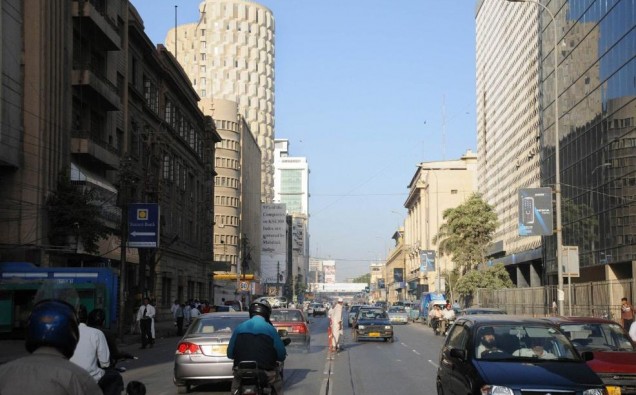
Karachi, Pakistan’s largest city Photo by Rahib ALi (Citizen)) [Public domain], via Wikimedia Commons
Lahore’s busiest Mall road remained the theater of protest rallies by politicians, farmers and teachers throughout the year 2016 and capital Islamabad’s central district also witnessed a number of activisits’ meetings.
On Pakistan’s eastern border, India remained on an aggressive course, partly to divert international attention from its massacres in the occupied Jammu and Kashmir.
But political unrest and regional escalation failed to slow down economic upsurge of the South Asian country, which needs to sustain a high growth rate for decades to pull millions out of poverty.
Pakistan’s stock market was adjudged the fifth most performing bourse of the world with equities up by 45 percent in 2016, making the country, the best performing emerging market in Asia.
Foreign investors also remained focused on the country’s economic opportunities.
Even on the first working day of 2017, the PSX Index rose by another 300 to further build on the achievements of 2016. The Stock Exchange has been bullish for several months.
But how did that happen for a country which until recently was called the most dangerous place in the world, a front line state in the fight against terror?
According to economic analysts, this was all due to international confidence in what is going on in Pakistan economically as well as administratively.
The turning point came in 2013 with the election of the Nawaz Sharif as prime minister, who remains dogged by corruption scandals but his government is considered both internally and externally as business friendly. In the same year, Pakistan’s army chief Gen (retd) Raheel Sharif, who retired last year, started waging a concerted campaign against terrorists including the Tehrik e Taliban Pakistan in the trial areas along the Afghan border. The Zarb e Azb operation, which continues to this day. eliminated thousands of terrorists and reduced the number of terror attacks in Pakistani cities considerably. At the same time, Islamabad began an operation to clear Karachi of criminals, gangsters and political thugs, who had for long held the country hostage to their freewheeling.
All these steps helped the country regain control of tribal lands, pull down the crime rate in Karachi and give a message of stability to foreign and domestic investors and businesses.
On the economic front, budget deficits, inflation and policy interest rates fell to record lows. The $6.7 billion IMF structural adjustment program has been concluded.
The major boost, however, came in the form of $46 billion Chin Pakistan Economic Corridor, which is producing thousands of jobs and stepping up economic activity in all four provinces.
Pakistan has also raised more than $3 billion in Eurobonds/Sukkuk in the international capital markets.
In the realm of foreign policy, Pakistan was able to win more friends despite Indian moves to use Pathankot and Uri militant attacks to isolate Pakistan internationally.
Islamabad was able to engage its Cold War era foe, Russia to its side while further cementing its relations with friend China. The December 27 triangular meet of Pakistan, China and Russia in Moscow unnerved New Delhi, where strategic affairs experts take this move as a zero sum game.
China and Russia also frustrated an Indian move to declare Pakistan a terrorist state at BRICS summit. At the Heart of Asia Conference in India, Moscow clearly sided with Pakistan, and has also said it would lik its own corridor with the CPEC – a development which has also upset New Delhi. Iran and central Asian countries also want to be part of the energy and trade corridor linking the Gulf and other regions through Pakistan’s Gwadar port in Balochistan – a province where India has been sponsoring militancy throughout the last decade.
In the United States, President-elect Donald Trump has indicated his desire to have a close business relationship with Pakistan, after years of tense relations under the Obama Administration.
In 2017, Pakistan sees a lot of promise. A series of energy and infrastructure projects have been planned in order to drive the country out of energy crisis, which in recent years has been harming economic prospects with a power shortage of 5000 to 7000 megawatts in summers.
If Pakistan’s ties with the incoming Donald Trump administration also warm up, as pledged, Pakistan will look forward to a much better time ahead. In turn, Pakistan’s stability will also help the US achieve its goal of peace and security in Afghanistan.















